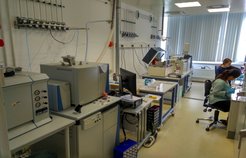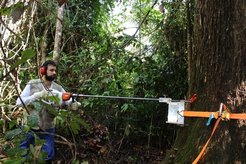isoTROPIC Facilities
The Isotope Laboratory

This facility provides state-of-the-art laboratory facilities for the isotopic analysis of archaeological remains, including reference and carrier gas infrastructure, pretreatment facilities, and five mass spectrometer systems. This equipment enables the stable isotope analysis of archaeological plants, soils, and human and animal tissues; the compound specific isotopic analysis of biomarkers from archaeological and palaeoenvironmental sediments; and the isotopic analysis of fatty acids from pottery. This facility is one of the very few dedicated isotopic facilities for archaeology and palaeoecology globally.
The laboratory facilities support the diverse projects of PhD students, postdoctoral researchers, and visiting scholars that stretch well beyond the tropics, ranging from the migration history and modern ecology of wildebeest in East Africa to the social and environmental impacts early rice agriculture in Asia, from the adaptations of early Homo sapiens and its hominin relatives to the causes of Pleistocene and Holocene megafaunal extinctions.
For more information on the isotope laboratory, visit the facilities of the Department of Archaeology.
The Remote Sensing Laboratory
This facility will house LiDAR (Light Detection and Ranging) and drone capabilities for applications of remote sensing in archaeology. LiDAR technology uses laser sensors attached to aerial vehicles that bombard the ground with hundreds of thousands of pulses of light. The speed and frequency with which these pulses are reflected back to the instrument are measured and plotted in space. By applying computer algorithms, a relief map of the area can be constructed, revealing landscape modifications even through dense canopy settings.
The application of LiDAR has been revolutionary in tropical forest contexts, yielding insights into the extent and nature of settlements and structures in environments once thought to be ‘pristine’. The cost of this type of analysis, however, remains high, and is often prohibitive. The isoTROPIC facility will include a purpose-built drone and LiDAR set-up which can be deployed around the world. Supported by expert data analysts and a dedicated technician, in tandem with our partners at École française d’Extrême-Orient, Paris, we seek to dramatically increase the availability of LiDAR in archaeological research programmes across the tropics and beyond.
The Dendrochronology Facility
Recent years have seen a significant increase in the application of dendrochronology in the tropics. Despite initially being considered impossible due to a perceived lack of tropical environmental seasonality, dendrochronological study has now demonstrated that more than 200 tree species form annual rings in tropical regions. While the annual nature of these rings has been debated, multidisciplinary analysis (ring counting, radiocarbon dating, isotope analysis) can provide insights into the growth patterns of living trees over time, and how this might be connected to climatic variables or human management.

The isoTROPIC dendrochronology facility includes a novel sampling set-up (motorised borer and support) (see Caetano-Andrade et al., 2021) for the coring of large tropical trees. It also includes scanning and counting facilities for the documentation of tree rings and the sampling of tree cores for various biogeochemical analyses. The facility aims to support the application of this approach to novel parts of the tropics to explore the legacies of human activity left in the tissues of living trees which stand as monuments to both the cultural and natural heritage of these regions (Caetano-Andrade et al., 2020).

